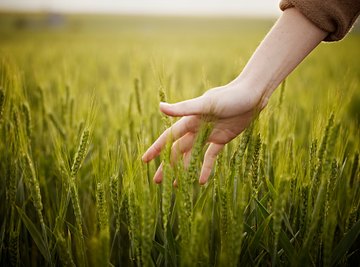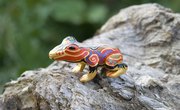
Tactile materials utilize your sense of touch, which is frequently overlooked. Educators use them to teach young children and those who are visually impaired about our world. Tactile materials vary from natural to synthetic, and many can be found around the house. Pincer grasp skills are exercised with these materials, and blind children transition tactile activities to learning braille. Moreover, museums, such as the Metropolitan Museum of Art and the Smithsonian, have adopted hands-on exhibits to teach children through touch.
Food
Food is an inexpensive tactile material that can be found around the house. Cooked pasta in different shapes, dry beans, rice and nuts, let young children practice their fine-motor skills and pincer grasping. Developing fine-motor skills is helpful for learning to draw and later write.
Sand
Wet and dry sand have different properties, and children can feel their way through play. Wet sand can be molded into containers and mounded into shapes. Sticks and rakes can be used to create lines in wet sand, and other toys can leave imprints in it. Dry sand runs through a child's hands and sieves. Marks can be made in dry sand, and funnels are a way to feel the flow of this tactile material.
Water
A paddling pool is a way to engage in water play beyond the bathtub. Different containers can be offered to pour water, and children can be asked if they think certain objects will float or sink. Items from the ocean such as dried seaweed and sea sponges change shape when rehydrated, and bubble play can also be included during water play.
Natural Materials
A nature walk can provide lots of tactile materials. For example, grass on bare feet feels different than dry leaves, and children can gather items such as sticks, rocks and acorns. Each has a different sensation, and children can experiment with natural tactile materials. Science museums with hands-on exhibits may have animal furs and feathers, and some aquariums allow visitors to touch fish and other water creatures.
Play Dough
Play dough is a fun project to make and for children to play with. Children can make objects or just push it through their fingers. Play dough can be made with easy homemade recipes or be purchased inexpensively from toy stores. Like wet sand, it can be molded and stays in specific shapes. When dry, play dough will harden, retaining its shape.
Beads and Lacing
Plastic beads are quite tactile, and teaching children to lace beads builds fine-motor skills for writing. A popular kindergarden activity is using fingers to pincer grasp the small beads. Like beans, beads are a fun way to teach children, and lacing necklaces builds concentration and patience.
References
About the Author
Charong Chow has been writing professionally since 1995. Her work has appeared in magazines such as "Zing" and "Ocean Drive." Chow graduated from the University of Miami with a Bachelor of Arts in philosophy. She also received a Bachelor of Fine Arts from the California Institute of the Arts.
Photo Credits
Thomas Barwick/Lifesize/Getty Images
